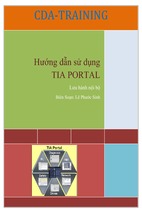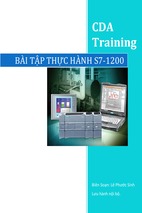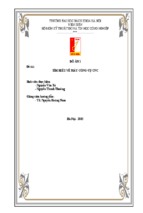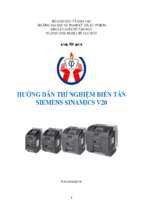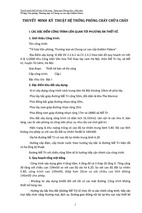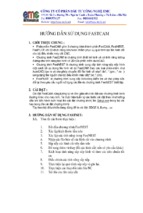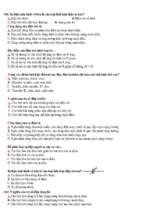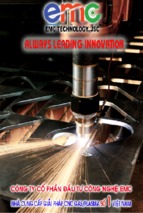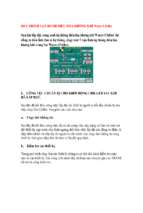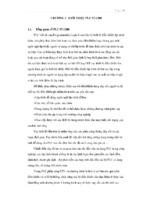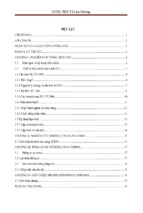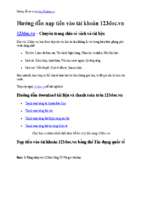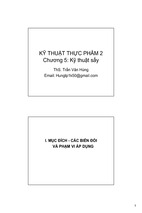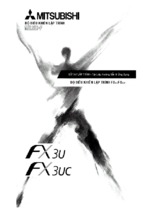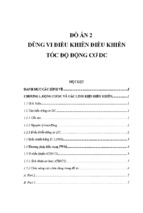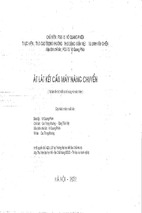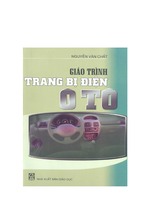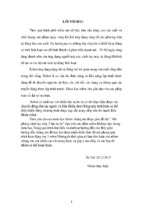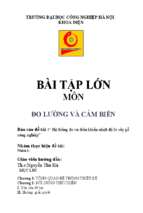Mô tả:
Sustainable Manufacturing and Factory
Planning
Production Planning and Control III
12.04.2017
Technische Universität Berlin
Institute for Machine Tools and Factory Management
Univ.-Prof. Dr.-Ing. Holger Kohl
© IWF TU Berlin
Page 1
Table of Contents
Introduction
Modeling
Discrete Event Simulation in PPC
Operations Research Methods in PPC
Literature and References
Technische Universität Berlin
Institute for Machine Tools and Factory Management
Univ.-Prof. Dr.-Ing. Holger Kohl
Page 2
Factory
Exemplary processes:
Designing
Producing
Assembling
Work schedule building
Sales planning
Testing
festo.com
Value creation module
Grinding
Factory
Polishing
Transportation
Challenge:
A factory is a complex system:
Dynamic behavior (change of status
over time)
Controlling
Storing
lagerwirtschaft.info
siemens.de
Cutting
Elements with relations, high complexity
Technische Universität Berlin
Institute for Machine Tools and Factory Management
Univ.-Prof. Dr.-Ing. Holger Kohl
Source: [VDI-5200]
Page 3
Ways to study a system
Ways for a model-based analysis of products, processes, equipment and the organization in the
factory management.
Systems
Technische Universität Berlin
Institute for Machine Tools and Factory Management
Univ.-Prof. Dr.-Ing. Holger Kohl
www.es3d.de
Analytical solution
Experiments
Simulation
Physical
model
Mathematical model
Simulation
Crash Test
Simulation Crash Test
www.auto.de
Model
required
Experiment with a
model of the system
www.welt.de
www.ep-photovoltaik.de www.siemens.de
Experiment with the
current system
Finite-Element-Net
Source: [Law-00]
Page 4
Table of Contents
Introduction
Modeling
Discrete Event Simulation in PPC
Operations Research Methods in PPC
Literature and References
Technische Universität Berlin
Institute for Machine Tools and Factory Management
Univ.-Prof. Dr.-Ing. Holger Kohl
Page 5
Model
Simplified reproduction of a planned or existing system with its processes in a different
conceptual or concrete system.
Its differences from the real system in terms of its characteristics that are relevant to the
investigation are within a given range of tolerance.
[VDI-3633]
Each Model is only a limited valid representation of the original.
The representations purpose determines the model type and degree of detail.
System models form the effect structures in a way that describes the system behavior.
Simulation models form the system behavior in a way so that they can be simulated.
Technische Universität Berlin
Institute for Machine Tools and Factory Management
Univ.-Prof. Dr.-Ing. Holger Kohl
Quelle: [VDI-3633]
Page 6
Modeling: From the system to the model
Goal: mapping of a real or fictive system.
System barrier
System elements
Abstraction from the Original to the Model
(mapping of relevant attributes).
Modeling by focusing on special aspects,
e.g. technology, logistics of a production
system with appropriate level of detail.
E2
Input
E1
E.g. logistics of a factory, assembly /
manufacturing processes, capacities,
schedules, places.
Output
E5
E4
E3
Level of detail and the size of the model
depends on the goal of the analysis, e.g.:
Original (system, reality)
Model
Reduction of cycle times,
reduction of queues,
capacity balancing.
modeling / models do not have an end in
itself; they can end in an aimless analysis.
Input
E2
E1
E3
Output
E5
E4
A model is an abstracted reproduction of a system.
Technische Universität Berlin
Institute for Machine Tools and Factory Management
Univ.-Prof. Dr.-Ing. Holger Kohl
Source: [Küh-06]
Page 7
Abstraction
Detailed
model doesn’t
lead often to
effectiveness
Technische Universität Berlin
Institute for Machine Tools and Factory Management
Univ.-Prof. Dr.-Ing. Holger Kohl
Bad, imprecise
model leads to
no or bad
perceptions
Source: [ASIM-09]
Page 8
Modeling Modes
Modeling approaches:
Planning Levels
Network
B
o
t
t
o
m
u
p
Factory
Departments
System
Cell
Technische Universität Berlin
Institute for Machine Tools and Factory Management
Univ.-Prof. Dr.-Ing. Holger Kohl
Top-down:
Initial point: the overall
system which has to be
modeled (factory
location, factory area)
with undetailed
subsystems.
Bottom-up
Modeling of
subsystems.
Then these subsystems
Workstation
Process
T
o
p
d
o
w
n
E.g. Milling
will be connected to
bigger subsystems, until
the whole system is
modeled.
Quelle: [Wie-07]
Page 9
Digital Model (examples)
Classification:
Digital Model
Static Model
Dynamic Model
Geometry oriented
Structure- und processoriented models
2D-Models
Bill of materials
(BOM)
Discrete-event
oriented model
3D-Models
Work schedules
Kinematic model
Further focus
Technische Universität Berlin
Institute for Machine Tools and Factory Management
Univ.-Prof. Dr.-Ing. Holger Kohl
Simulation models
Finite-ElementModels
Quelle: [Küh-06]
Page 10
Table of Contents
Introduction
Modeling
Discrete Event Simulation in PPC
Operations Research Methods in PPC
Literature and References
Technische Universität Berlin
Institute for Machine Tools and Factory Management
Univ.-Prof. Dr.-Ing. Holger Kohl
Page 11
Simulation
Simulare [lat]: immitate, dissemble, copy
“Representation of a system with its dynamic processes in an experimentable model to reach
findings which are transferable to reality; in particular, the processes are developed over time.
“[VDI-3633]
Simulation supports the evaluation of e.g.
schedule alternatives,
emergency strategies,
training of new employees,
prognosis,
quantity planning,
order monitoring,
Technische Universität Berlin
Institute for Machine Tools and Factory Management
Univ.-Prof. Dr.-Ing. Holger Kohl
Quelle: [VDI-3633]
Page 12
What is Simulation ?
….look into the future, predicting what can or will happen (Gartner 2010)
….to know what happens before it happens (Rockwell Software)
….. if you do not know it, simulate it
….answering the „What if..“ questions
Technische Universität Berlin
Institute for Machine Tools and Factory Management
Univ.-Prof. Dr.-Ing. Holger Kohl
Page 13
Some Benefits of Simulation
Improves the decision making with minimal costs
Compress and expands time to achieve a required level of detail
Explore possibilities with minimal expenses
Understand the complexity of a system and diagnose problems
Identify system constrains and limitations
Test and evaluate possible solutions
Examine the dynamic behaviour of a system
Technische Universität Berlin
Institute for Machine Tools and Factory Management
Univ.-Prof. Dr.-Ing. Holger Kohl
Page 14
Arguments to Apply Simulation
When:
New technology / methods are entered,
The limit of analytic methods is reached,
System connections are too complex for human imagination
Experiments on the real system are not possible or are too
expensive,
The dynamic behaviour of a system is object of the analysis.
(combinations are possible)
Technische Universität Berlin
Institute for Machine Tools and Factory Management
Univ.-Prof. Dr.-Ing. Holger Kohl
Page 15
Simulation cycle
A general procedure of a simulation project.
A well defined goal of the
simulation study has to be
formulated initially, since the
degree of abstraction
dependents on this.
Simulation itself does not
involve any optimization.
However, the systematic
Simulation cycle
Technische Universität Berlin
Institute for Machine Tools and Factory Management
Univ.-Prof. Dr.-Ing. Holger Kohl
variation of parameters
can be supported by
mathematical
optimization procedures
to achieve a favorable
parameter configuration
in terms of the simulation
goals.
Source: [Küh-06], [VDI-3633]
Page 16
Example
Technische Universität Berlin
Institute for Machine Tools and Factory Management
Univ.-Prof. Dr.-Ing. Holger Kohl
Page 17
Model Components for Simulation Models
SIMULATION MODEL
CAPACITY
PRODUCTS
MANUFACTURE
CONTROL
Machine Tools
Process Plans
Order Release
Utilisation
Fixtures
Routings
Dispatch
Lead Time
Tools
Lot Sizes
Conveyors
Production
Programme
Transport
control
Production
Output
Buffers
Technische Universität Berlin
Institute for Machine Tools and Factory Management
Univ.-Prof. Dr.-Ing. Holger Kohl
EVALUATION
Page 18
Discrete Event Simulation
Modelling and simulation of events that occur over the time, with variability and system
interactions to provide highly accurate predictions of system performance and capabilities
under a virtual set of conditions.
Discrete event simulation
In a discrete event-oriented simulation, the changes in the system occur in a defined point of time.
Once the event occurs, a change in the system condition takes place. Events controls the progress in
the simulation. It is assumed that between events there is not any change in the state of the system.
Components of the system can be in any one of a number of discrete states at any point of time
(machine may be idle or working).
Components change from one state to another instantaneously.
Discrete modeling considered changes occur instantaneously even though in real life may take
a short period of time (loading and unloading of a job into a machine).
Two basic elements :
Rules which determine when the next event occur,
Rules for changing the state of the model when the next event occurs.
Technische Universität Berlin
Institute for Machine Tools and Factory Management
Univ.-Prof. Dr.-Ing. Holger Kohl
Source: [VDI-3633]
Page 19
Continuous vs. discrete event simulation
Simulation
modelling
• independent variable: time
Discrete
event simulation
• dependent variables: function of time (e.g.
machine status, number of parts)
Combined
simulation
Dependent variables:
change only at distinct points in
simulation time
(e.g. machine change status from
busy to idle, broken or booked)
Time
Technische Universität Berlin
Institute for Machine Tools and Factory Management
Univ.-Prof. Dr.-Ing. Holger Kohl
Dependent variables:
are continuous function of time
(e.g. time required to unload an
oil tanker)
Dependent
variable
Dependent
variable
Discrete event simulation
Continuous
simulation
Time
Continuous simulation
Source: [VDI-3633]
Page 20
- Xem thêm -

